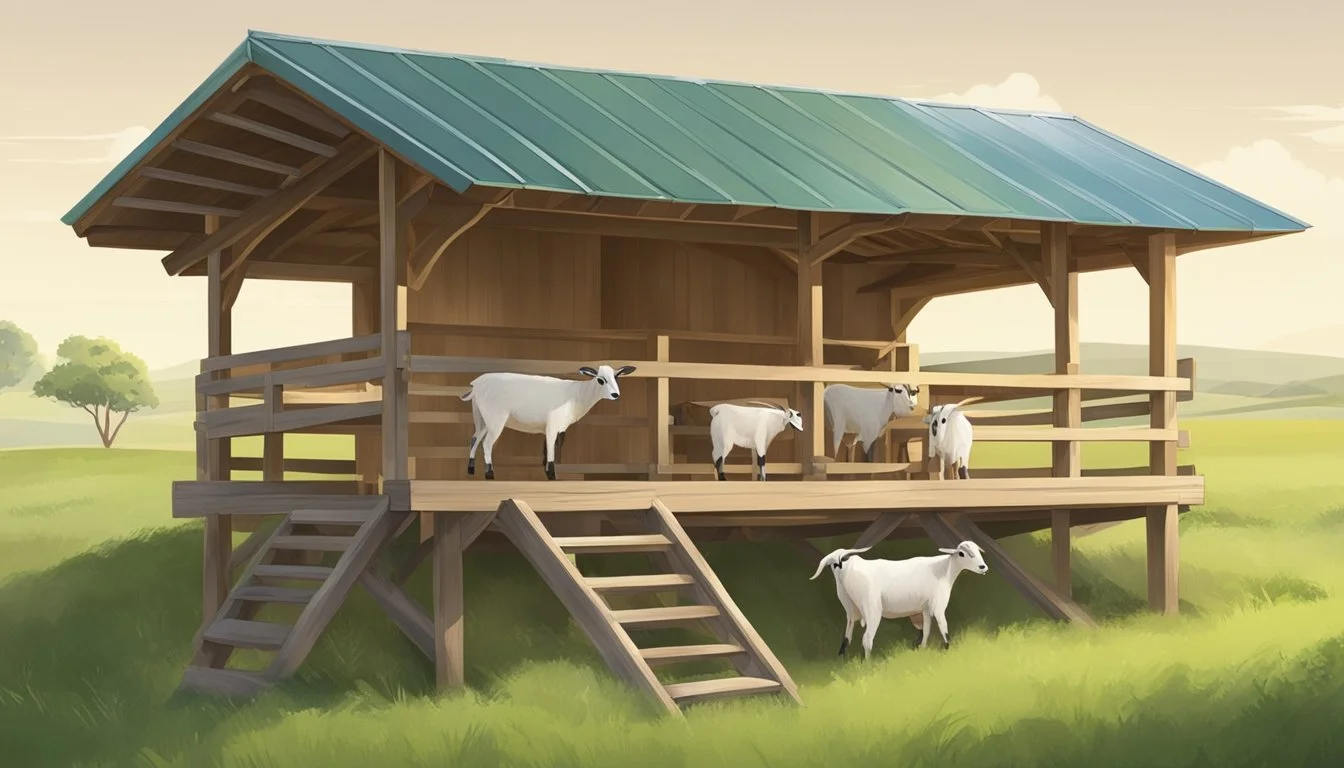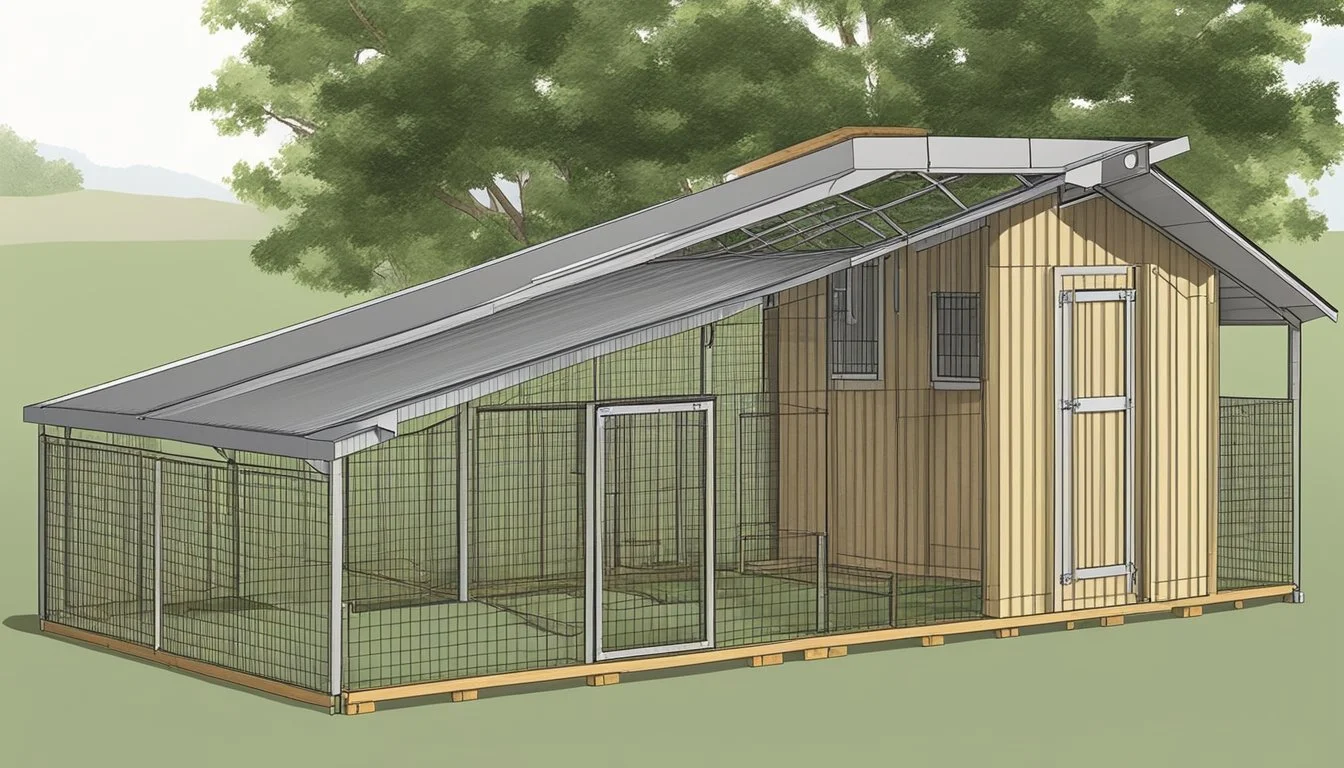Building a Sustainable Goat Shelter
Essential Strategies for Eco-Friendly Housing
Raising goats can be a fulfilling venture, whether for agricultural, commercial, or self-sufficiency purposes. However, one critical component of goat husbandry is providing suitable shelter. A sustainable goat shelter is crucial not only for the wellbeing of the animals but also for the long-term efficiency and functionality of a farm. These shelters serve numerous purposes: they protect goats from harsh weather, create a space for them to rest and sleep, and can also be a place for feeding and kidding.
When considering the design and construction of a goat shelter, sustainability factors into choices of materials, location, and size. Using locally-sourced, eco-friendly materials not only reduces the carbon footprint of the shelter but also blends with the environment. The design should incorporate features that accommodate the goats' natural behaviors while promoting good health, such as proper ventilation to prevent respiratory issues and ample space to prevent overcrowding.
Crafting the ideal goat shelter also involves strategic planning to avoid future expansion or reconstruction costs. For instance, considering the number of goats and the potential herd growth will determine the necessary size of the shelter. Durable construction that withstands weather elements without frequent maintenance ensures the shelter remains sustainable and cost-effective over time. With these considerations in mind, goat keepers can ensure their animals have a safe and comfortable environment that also supports the sustainability goals of their operations.
Understanding Goat Shelter Requirements
When designing a goat shelter, it's vital to consider protection from the elements, appropriate space based on breed, and the varying climate impacts on shelter design.
Importance of Shelter for Goats
Goat shelters serve as a refuge from wind, rain, and snow, ensuring the well-being of the goats. It's about more than just comfort; a sturdy shelter contributes to the animals' overall health and safety. They require a space that provides sufficient ventilation to prevent respiratory issues while keeping them dry and out of the direct path of harsh weather conditions.
Climate Considerations and Shelter Design
The climate heavily influences the structural integrity and features of a goat shelter. In regions prone to heavy snowfall, the shelter must have a robust roof capable of bearing that weight. Conversely, in warmer areas, the design should focus on maximizing air flow to aid in cooling. Materials used must be durable against the prevailing weather while providing secure insulation in colder environments.
Space Needs for Different Goat Breeds
Different goat breeds have varying spatial requirements. Standard-sized goats typically necessitate at least 15 square feet per individual, while smaller breeds like miniature breeds and pygmy goats can be adequately accommodated with around 10 square feet each. A shelter should not only cater to the current number of goats but also to potential herd growth. The specific needs of each breed affect not just the size but also the internal configuration of the shelter, ensuring that all goats have access to the space necessary for their health and natural behavior.
Planning Your Goat Shelter
When considering the construction of a goat shelter, attention to detail is essential. Optimal site selection, consideration of sustainable design principles, and meticulous budgeting of materials underscore the planning phase.
Before You Begin: Site Selection and Preparation
One should select a dry, elevated area that shields from direct wind. The ground at the chosen site must be well-drained to prevent issues related to moisture. Site preparation involves clearing debris and ensuring a level surface, which serves to lay a solid foundation for the shelter.
Choosing a Sustainable Design
Sustainable designs not only benefit the environment but also can be more cost-effective in the long run. A slanted roof, for example, can enhance rainwater runoff, and incorporating natural light can reduce the need for artificial lighting. Selection should consider the specific needs of the goats, such as space for feeding and resting.
Materials List and Budgeting
The selection of materials is guided by durability, environmental impact, and cost. A materials list will typically include:
2x4 boards for framing
Roofing material (e.g., metal sheeting or shingles)
Fasteners and hinges for doors, if applicable
Budgeting should account for all materials and potential labor costs. It's also prudent to consider the skill level required; for those with basic skills, simpler goat shelter plans that use readily available materials can be both cheap and effective.
Design Principles for a Sustainable Goat Shelter
When constructing a sustainable goat shelter, it is essential to maximize the use of natural resources, ensure proper insulation and ventilation, and incorporate efficient storage solutions. These principles support environmental sustainability while providing a comfortable space for goats.
Maximizing Natural Resources
Using recycled materials in a goat shelter is not only cost-effective but also lessens the environmental impact. For the structure, builders can utilize repurposed wood or metal. The roof materials could be sourced from reclaimed metal or sustainable composites. Positioning the shelter to take advantage of natural light and heat can also reduce energy costs.
Ensuring Proper Insulation and Ventilation
A goat shelter must balance insulation and ventilation to protect the animals from extreme temperatures. Insulation made from eco-friendly materials like sheep’s wool or recycled denim ensures a comfortable space. Adequate ventilation, potentially through strategically placed vents or openings, is crucial to prevent moisture buildup and maintain air quality.
Incorporating Storage Solutions
Integrating storage within the goat shelter enhances functionality. Shelving or cabinets made from sustainable materials can hold feed and goat care tools. If space allows, a dedicated area for supplies keeps the shelter organized, ensuring ease of access and efficient use of space.
DIY Goat Shelter Construction
Constructing a DIY goat shelter can be straightforward and economical. This section provides a practical guide to building a basic shelter, details on creating lean-to and A-frame designs, and advice on using pallets and other cost-effective materials.
Step-by-Step Instructions for Building a Basic Shelter
Building a basic DIY goat shelter requires careful planning and execution. One must select an elevated, dry area to prevent water accumulation, which can cause health issues for goats. Starting with a materials list is crucial, typically including 2x4s for the frame, a roofing material, fasteners, and tools. Step-by-step instructions should cover the base construction, raising walls, and roof installation. For extra durability, one might choose to use pressure-treated lumber for the parts of the shelter that will touch the ground.
Lean-to and A-frame Designs
Lean-to shelters are an easy-to-build option that provides good protection from the elements. An A-frame goat shelter requires more materials and labor but offers excellent durability and wind resistance. Both designs promote water run-off and can be constructed using cheap lumber or recycled materials. Properly spacing the rafters and ensuring a slanted roof for drainage are key design elements.
Using Pallets and Other Cost-Effective Materials
Utilizing pallets in shelter construction is a cost-effective and eco-friendly choice. Pallet shelters can be easily assembled as the framework is already in place, making for an easy pallet shelter solution. Incorporating other cheap and recycled materials, such as corrugated metal sheets for roofing and reclaimed wood, further reduces costs and environmental impact. Ensure all used materials are safe and free from harmful chemicals to protect the health of the goats.
Detail Work and Finishing Touches
Every goat shelter needs attention to the finer details to ensure its practicality and durability. From the choice of roofing materials to the incorporation of accessibility features, these elements are crucial for creating a safe and comfortable space for goats.
Roofing Material and Installation
Selecting the appropriate roofing material is key for the shelter's longevity and the goats' protection. A slanted roof design, typically using materials like corrugated metal or shingles, helps to efficiently divert rainwater away from the shelter. It's important to ensure that the roofing panels are securely fastened to withstand strong wind and adverse weather.
Doors, Windows, and Accessibility Features
Doors should be built to be sturdy yet easily operable, ideally fitted with hinges that resist rust and degradation. Windows provide ventilation and are essential for a comfortable space, they must be high enough to prevent goats from jumping out. Including ramps can improve accessibility, making the shelter welcoming for goats of all ages and physical conditions.
Customizing Shelters for Added Comfort
Inside the shelter, details matter. For added comfort, one can install partitions for goats to have their own comfortable space and removable bedding for easier cleaning. Strategic placement of hay feeders and water containers keeps the interior organized and functional for the goats’ daily activities.
Safety Precautions and Longevity of Shelter
The durability and safety of the structure is non-negotiable. Using safe materials free of sharp edges, and applying non-toxic paints or stains can extend the shelter’s lifespan while safeguarding goat welfare. Regular inspections for signs of wear and instant reparations contribute significantly to the shelter’s longevity.
Maintenance and Upkeep
Regular maintenance is essential for the longevity of a goat shelter. Routine care and addressing wear and tear promptly ensures the sustainable operation of the structure.
Routine Care for Sustainable Shelters
Sustainable shelters rely on consistent upkeep. Bedding, such as straw or wood shavings, should be inspected daily and changed regularly to maintain a clean and dry environment. This not only promotes the health of the goats but also extends the life of the shelter by preventing the build-up of moisture and waste, which can degrade the shelter materials over time.
Daily Maintenance Tasks:
Inspect and remove soiled bedding.
Check for and clear away any accumulated waste or spilled feed.
Ensure water sources are clean and functional.
Addressing Wear and Tear
Over time, even the sturdiest goat shelters can succumb to wear and tear. Staying vigilant about minor repairs can prevent larger issues. For instance, a small hole in the roofing can lead to leaks that compromise the shelter's integrity and the goats' comfort. Periodically scrutinize the shelter's structure—especially the roof and support beams—and address issues such as:
Structural Integrity Checks:
Inspect for loose or damaged boards and fix them immediately.
Replace or repair any compromised parts of the roofing.
Examine and fortify structural connections and joints to ensure stability.
Incorporating these maintenance practices preserves the shelter's condition and provides a secure and comfortable home for the goats.
Additional Considerations
In constructing sustainable goat shelters, one must meticulously plan beyond the basic structure to ensure the well-being of the goats. Strategically designed food and water arrangements, along with provisions for multi-species compatibility, are essential components of a successful shelter.
Food and Water Arrangements
Food and water availability plays a pivotal role in the daily lives of goats. For comfortable space utilization, consider incorporating built-in feeders and water troughs to minimize waste and to keep the shelter tidy. It is imperative to position these elements in easily accessible areas that can accommodate all goats without crowding. Regular cleaning and maintenance are crucial to prevent the buildup of contaminants, which can affect the herd's health.
Feeder types: Hanging, standalone, or trough feeders.
Water sources: Automatic waterers, buckets, or troughs.
Accommodating Multi-Species Livestock
When raising goats alongside other livestock, like sheep, it is important to design a shelter that caters to the needs of multiple species. This includes assessing the space requirements and behavioral patterns of each animal to avoid conflicts and stress. Barriers or sections within the shelter that foster peaceful coexistence are recommended, ensuring sufficient access to food, water, and rest areas for all inhabitants.
Partitioning: Use panels or fencing to create separate areas.
Common space: Designate areas for shared activities, promoting harmony.




